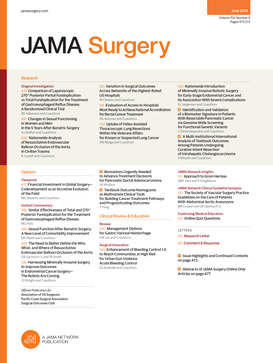Fluorescence-Guided Surgery for Assessing Margins in Head and Neck Cancer
IF 15.7
1区 医学
Q1 SURGERY
引用次数: 0
Abstract
ImportanceHead and neck squamous cell cancer (HNSCC) is associated with a higher positive margin rate compared with most other cancers in surgical oncology. This rate has remained stagnant over the past 3 decades. Fluorescence-guided surgery (FGS) is a promising tool to address high positive margin rates in multiple solid tumor types, including HNSCC. This review summarizes data from a decade of FGS research in this tumor type to outline how fluorescence can help improve margin clearance, especially at the deep margin. The principles presented can be broadly applied using HNSCC as a model disease.ObservationsIn contrast to the superficial mucosal margin, the deep margin is especially challenging for surgeons to visualize and contributes to the vast majority of positive margins and subsequent sequelae in HNSCC. Using fluorescence in vivo can highlight residual disease in the resection bed, while using fluorescence ex vivo can highlight how close the tumor margin is from the resection surface of the specimen, guiding sampling and further resection.Conclusions and RelevanceCurrently, there are several clinical trials investigating FGS to improve margin clearance in HNSCC, with many fluorescent agents already approved for use in other cancer types. As additional agents are brought into clinical use, it will be critical to understand how this technique will or will not improve oncological management in our patients. To address this important point, we present 2 key areas where surgeons will consider use of these FGS: to assess the peripheral mucosal margin and the deep surface of the tumor. We outline how in vivo and ex vivo fluorescence can be used for this purpose. We summarize data from multiple sources to explain how FGS is most likely to help with deep margin clearance.荧光引导手术评估头颈部癌边缘
重要性头颈部鳞状细胞癌(HNSCC)与外科肿瘤学中大多数其他癌症相比具有较高的阳性切缘率。这一比率在过去30年里一直停滞不前。荧光引导手术(FGS)是一种很有前途的工具,用于解决多种实体肿瘤类型的高阳性切缘率,包括HNSCC。这篇综述总结了十年来FGS在这种肿瘤类型中的研究数据,概述了荧光如何帮助改善边缘清除,特别是在深边缘。所提出的原则可以广泛应用于将HNSCC作为模型疾病。与浅表粘膜缘相比,外科医生很难观察到深粘膜缘,并且在HNSCC中绝大多数阳性边缘和随后的后遗症都是深粘膜缘造成的。在体内使用荧光可以突出切除床的残留病变,而在体外使用荧光可以突出肿瘤边缘离标本切除面有多近,指导采样和进一步切除。目前,有几项临床试验正在研究FGS改善HNSCC的边缘清除率,许多荧光剂已经被批准用于其他类型的癌症。随着其他药物进入临床使用,了解这项技术将如何改善患者的肿瘤管理将是至关重要的。为了解决这一重要问题,我们提出了外科医生将考虑使用FGS的两个关键领域:评估周围粘膜边缘和肿瘤的深表面。我们概述了体内和离体荧光如何用于此目的。我们总结了来自多个来源的数据,以解释FGS如何最有可能帮助进行深保证金清理。
本文章由计算机程序翻译,如有差异,请以英文原文为准。
求助全文
约1分钟内获得全文
求助全文
来源期刊

JAMA surgery
SURGERY-
CiteScore
20.80
自引率
3.60%
发文量
400
期刊介绍:
JAMA Surgery, an international peer-reviewed journal established in 1920, is the official publication of the Association of VA Surgeons, the Pacific Coast Surgical Association, and the Surgical Outcomes Club.It is a proud member of the JAMA Network, a consortium of peer-reviewed general medical and specialty publications.
 求助内容:
求助内容: 应助结果提醒方式:
应助结果提醒方式:


